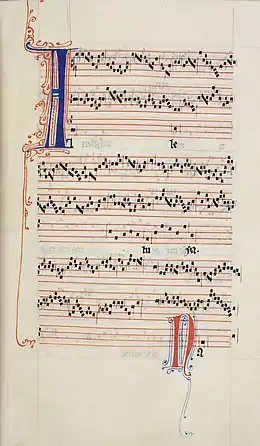Léonin (also Leoninus, Leonius, Leo; fl. 1135s–1201) was the first known significant composer of polyphonic organum. He was probably French, probably lived and worked in Paris at the Notre Dame Cathedral and was the earliest member of the Notre Dame school of polyphony and the ars antiqua style who is known by name. The name Léonin is derived from "Leoninus", which is the Latin diminutive of the name Leo; therefore it is likely that Léonin's given French name was Léo.
Overview
All that is known about him comes from the writings of a later student at the cathedral known as Anonymous IV, an Englishman who left a treatise on theory and who mentions Léonin as the composer of the Magnus Liber, the "great book" of organum. Much of the Magnus Liber is devoted to clausulae—melismatic portions of Gregorian chant which were extracted into separate pieces where the original note values of the chant were greatly slowed down and a fast-moving upper part is superimposed. Léonin might have been the first composer to use the rhythmic modes, and may have invented a notation for them. According to W.G. Waite, writing in 1954: "It was Léonin's incomparable achievement to introduce a rational system of rhythm into polyphonic music for the first time, and, equally important, to create a method of notation expressive of this rhythm."[1]
The Magnus Liber was intended for liturgical use. According to Anonymous IV, "Magister Leoninus (Léonin) was the finest composer of organum; he wrote the great book (Magnus Liber) for the gradual and antiphoner for the sacred service." All of the Magnus Liber is for two voices, although little is known about actual performance practice: the two voices were not necessarily soloists.
According to Anonymous IV, Léonin's work was improved and expanded by the later composer Pérotin. See also Medieval music.
The musicologist Craig M. Wright believes that Léonin may have been the same person as a contemporaneous Parisian poet, Leonius, after whom Leonine verse may have been named. This could make Léonin's use of meter even more significant.[2]
References
- ↑ W.G. Waite: The Rhythm of Twelfth-Century Polyphony: its Theory and Practice, . Yale Studies in the History of Music, New Haven, 1954.
- ↑ Notre Dame de Paris, Parisian Cathedral Music in the Twelfth and Thirteenth Centuries and Its Makers
Further reading
- Hoppin, Richard (1978). Medieval Music. The Norton Introduction to Music History (1st ed.). New York: W. W. Norton & Company. ISBN 978-0-393-09090-1.
- Gleason, Harold; Becker, Warren (1981). Music in the Middle Ages and Renaissance. Music Literature Outlines (3rd ed.). Bloomington: Frangipani Press. ISBN 978-0-88284-379-7.
- Articles Anonymous theoretical writings, Organum, Leonin, Perotin, The New Grove Dictionary of Music and Musicians, ed. Stanley Sadie. 20 vol. London, Macmillan Publishers Ltd., 1980. (ISBN 1561591742)
- Roesner, Edward H. (2020) [2001]. "Léonin". Grove Music Online. Oxford: Oxford University Press. doi:10.1093/gmo/9781561592630.article.40466. ISBN 978-1-56159-263-0. (subscription or UK public library membership required)
- Wright, Craig (Spring 1986). "Leoninus, Poet and Musician". Journal of the American Musicological Society. 39 (1): 1–35. doi:10.2307/831693. JSTOR 831693.
External links
- Free scores by Léonin at the International Music Score Library Project (IMSLP)
- Léonin at the Musopen project
